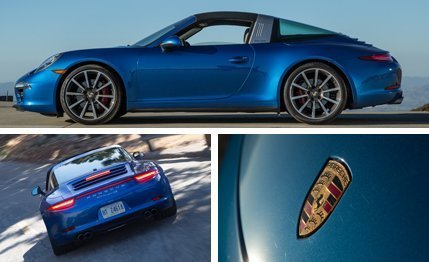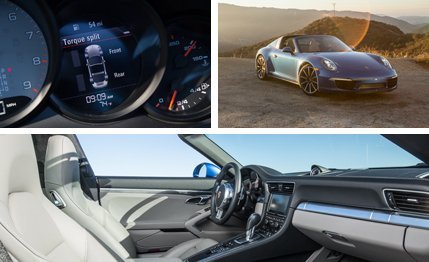 Instrumented Test
Instrumented Test
It was never Porsche’s first choice to build the original 911 Targa. Porsche planned to develop an open-air 911, but back in the 1960s, the future of the convertible was under threat by impending U.S. regulations, so the company came out with the Targa, an almost-convertible with a permanent roll bar.
With no droptop to compete with in the 911 lineup, the Targa gained a following despite its slightly awkward looks. A glass rear window soon replaced the original, zip-out plastic version. The stainless-steel roll hoop was eventually painted black. Even after Porsche released a real convertible 911 in 1983, Targa sales continued.
It wasn’t until September of 1993 that Porsche stopped building the basket-handle Targa with the lift-off top. The name continued, but subsequent versions had what was essentially a giant glass sunroof. Those glass-topped Targas are now gone—and the new Targa looks a lot like the old Targa.

Based on the latest 911, known among Porsche-philes as the 991, the new Targa is a clear homage to the original design, with a brushed-aluminum roll bar and that distinctive, curved-glass rear window. The roof’s operation, however, is thoroughly modern. With the push of a button, the rear glass lifts and glides backward along with what seems to be the entire rear end of the car. The trim at the top of the bar opens, the black-fabric-covered roof panel moves up and then back, nestling behind the rear seats, and the rear window whirs back into place. This automated metamorphosis takes 19 seconds. In the original Targa, this process required tools to release the top, getting out of the car, lifting the vinyl-covered top off the car, and then awkwardly folding the accordion-like roof to get it to fit in the front trunk. With a bit of practice, you might get it done in less than two minutes. For first-timers, it was closer to five.
The new Targa comes standard with four-wheel drive and can be had with either a 3.4-liter flat-six with 350 horsepower or the 4S’s 3.8-liter flat-six with 400 ponies. There’s no two-wheel-drive Targa, which makes us think that the Targa is the “convertible” for folks whose pants are stained with salt for five months of the year.
Although removing the top might not take as long as before, in 4S guise, the Targa proved to be a bit slower than the Carrera 4S. Our Targa 4S, which was equipped with the seven-speed dual-clutch automatic, hit 60 mph in 4.2 seconds and 100 mph in 9.8. The quarter-mile comes up in 12.6 seconds at 113 mph. As noted, these numbers are a few ticks behind those of a PDK-equipped Carrera 4S we previously tested. We’d surmise that the difference is largely due to the extra 144 pounds the Targa carries. The rear glass and its integral lid weighs 55 pounds, and Targas also begin life with the additional bracing found in the convertible 911. At 3630 pounds, the Targa 4S is the heaviest 991 we’ve tested; it’s even 42 pounds heavier than the Turbo S. On the plus side, we didn’t notice any structural quivers.

Despite carrying the equivalent of an extra passenger, the Targa 4S still grips to the tune of 0.99 g and stops from 70 mph in a very strong 148 feet. When pressed, it’s incredibly stable and secure. There’s virtually no body roll, and Porsche’s optional Dynamic Chassis Control ($3160) keeps the eventual loss of grip neutral and safe. It’s hard to believe that 61 percent of the mass presses on the rear wheels. Now, a quick whine about the continued growth of the 911 species: Some of the toylike character and liveliness we’ve come to love in 911s is gone in the latest version. That said, the 991 still feels smaller than its rivals such as the Nissan GT-R and the Chevrolet Corvette.
With the top in place, the Targa acts much like the coupe. There’s no additional wind noise and the sound-level meter registers 71 decibels at 70 mph—actually quieter than the aforementioned 4S coupe. In our earlier first drive of the Targa, we noticed some squeaks where the roof seals meet the windshield frame. Porsche must have addressed the problem, as our test car didn’t utter a peep. Opening the top brings in the wind and noise, but at lower speeds the raspy sound of the flat-six playing through the $2950 Sport exhaust is all you’ll remember.
That louder exhaust was but one of the many options on our test car. Prices start at $117,195, but our car came equipped with $29,815 in extras. How is that possible? The biggies are the two-tone leather interior that adds $4120, the dual-clutch automatic costs $4080, LED headlights are $3110, the Premium Package Plus commands $2330, 14-way Sport seats with memory are $2120, and the Sport Chrono Package boosts the price by $2370. If those numbers sound ridiculous, remember that, like the look of the new Targa, the high price of the 911 is also a tradition at Porsche.